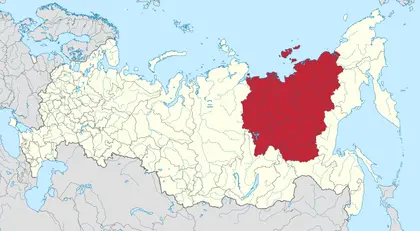As the Russian Empire expanded eastward it engulfed many of the populations scattered throughout Siberia. Long a rich source of diamonds, oil and minerals, the Republic of Sakha (also known as Yakutia), is now supplying the Russian Federation with a disproportionate amount of cannon fodder, much to the dismay of the indigenous population.
The Republic of Sakha is located in the Russian Far East, along the Arctic Ocean, with a population of roughly 1 million. Yakutsk is its capital and largest city. The republic has a reputation for an extreme and severe climate, with some of lowest temperatures ever recorded. Regular winter averages commonly dipping below −35°C (−31°F) in Yakutsk. The hypercontinental tendencies also result in warm summers for much of the republic.
JOIN US ON TELEGRAM
Follow our coverage of the war on the @Kyivpost_official.
The Sakha, or Yakut, people are the descendants of Turkic nomads and originated in the region around Lake Baikal. But in the 13th and 14th centuries Mongols arrived from the south, along with other peoples, and the Sakha moved north and east, settling eventually in the Lena river basin. Yakutsk was founded in 1632. In 1638 the Yakutsk province was established.
Moscow colonized and incorporated the area into the Tsardom in the 17th century, obliging the indigenous peoples of the area to pay fur tribute. The initial period following the Russian conquest saw the Sakha population drop by 70% as the Russian population there increased.

Russia Tries to Sabotage Moldova’s European Ambitions as It Did for Georgia and Belarus
Yakutia saw some of the last battles of the Russian Civil War, and the Bolshevik authorities re-organized Yakutsk province into an autonomous republic, the Yakut Autonomous Soviet Socialist Republic, in 1922. The Soviet era also saw the migration of many Slavs, specifically and Ukrainians, into the area.
With the demise of the USSR, the Russian Federation (RF) was established and within it the Republic of Sakha/Yakutia (RSY). The 1990s were economically brutal for much of the RF, but politically empowering for RSY. Glasnost-era ethnic-consciousness movements retained their momentum and led to a Sakha cultural revitalization. The RSY enjoyed greater financial autonomy over the profits of its natural resources, thanks to an agreement signed between RSY’s leaders and Boris Yeltsin.
Although Russians still continued to outnumber them, the Sakha regained some of their demographic strength, as tens of thousands of ethnic Russians returned to Russia proper.
This trend began to reverse when Vladimir Putin took office. Under his regime, Moscow has re-centralized power over its peripheral areas. The state has commandeered controlling interest in RSY’s diamond industry by becoming the majority shareholder of its monopoly company. In 2016, the RF initiated a homesteading act to repopulate Russia’s peripheral areas by granting free land to citizens willing to resettle there.
A Sakha representative living in the United States observed recently:
“My people got acquainted with the Russian world 400 years ago, the ‘pioneers’ in search of the ends of the earth came to our lands with fire and sword. They killed men, raped women and children. My ancestors resisted, but the technological advantage allowed the Russians to quickly conquer all of Yakutia.”
He described the dark pages in the history of his people as full of pain and suffering. “Only the vast size of my land and the dispersed living of my people made it possible to survive in such difficult conditions.”
With the passing of the years, the country has changed. But it remains a colony. “Moscow continues to pump out resources: gas, oil, gold, diamonds,” he said. “In response, we get polluted rivers, toxic waste. I, being a full-fledged citizen of the country, am a second-class person, I have fewer rights in my country than whites. Chauvinism and nationalism are the state policy of the country.”
Now he is facing the dilemma of whether or not to speak out.
“We were silent for a long time because we are afraid… we are being killed and this is happening today,” he said. “Even I, being safe here [in the U.S.], by saying these very words, endanger my relatives who now live there. But I have no right to remain silent. I want the whole world to recognize the Sakha people: modest, hardworking, kind, talented and eco-friendly people.”
On Sept. 21, 2022, Putin announced an additional mobilization of the military in the RF. There was an official statement in the media from the Ministry of Defense that 300,000 reservists would be called up.
While the official Russian authorities concealed the real statistics, an analysis of the first days of mobilization from Sept. 22 to Sept. 25, 2022 – conducted by anti-war activists in the RSY, the Republic of Buryatia, the Republic of Tuva, and the Republic of Kalmykia, as well as independent Russian media – showed ethnic selectivity and a blatantly disproportionate number mobilized from ethnic regions compared to the central regions and cities of the RF. Thus, from the small settlements of the Far North, almost the entire young able-bodied male population has been mobilized.
This disproportionate mobilization has further annoyed the Sakha people. Sakha representatives have joined U.S.-based Americans against Russian Imperialism. One of them summed it up simply: the national minorities within the RF are being used as cannon fodder in an unjust war.
The views expressed are the author’s and not necessarily of Kyiv Post.
You can also highlight the text and press Ctrl + Enter






